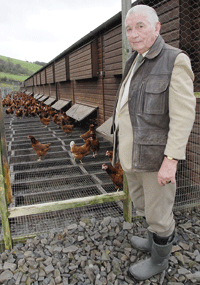Diversifying into organic poultry can reap rewards

Losing 3000 sheep and 500 cattle to foot-and-mouth in 2001 gave Haydn Jones and his son, David, the chance to rethink their management policy and consider introducing poultry at Llanbadarn Fynydd in Powys.
Visitors to a recent Organic Centre Wales organised farm walk heard that they opted not to continue trying to maximise cattle and sheep output on almost 584ha (1400 acres) of less favoured land at over 300m (1000ft).
“We wanted a slightly easier life and reducing stocking and switching to a low input organic system seemed to be the best option,” says Haydn, who started farming Y Ddol farm in 1951.
But the family didn’t just go organic, they added a poultry enterprise. The first free-range poultry were introduced after foot-and-mouth, as a diversification that was independent of land but could supply organic fertiliser.
The Welsh Assembly’s Farming Connect initiative, which aimed to boost family farm incomes, helped to finance the first 12,000-bird unit following a link up with an egg distributor, John Bowler Agriculture.
Open day visitors heard that the Jones family partnership, which included David’s wife Lynda, now had 58,000 birds, of which 21,000 were run on an organic system.
Mr Jones said that the enterprise provided morning employment for five local people and weekend work for others. The birds came in at 16 weeks old and went out for processing as spent hens at 72 weeks. The organic eggs were sold to Sainsbury’s.
Heather McCalman, head of the Grassland Development Centre at the Institute of Biological, Environmental and Rural Sciences at Aberystwyth, said organic conversion was a way for producers to reduce their vulnerability to increases in fossil fuel costs.
As the Jones family had demonstrated, it could also make farming systems more sustainable.
But Dr McCalman did warn: “The message is to think about all factors before deciding to go organic. Recently organic premiums had declined as, after 10 years of growing demand, housewives had become more reluctant to spend on organic foods.”
